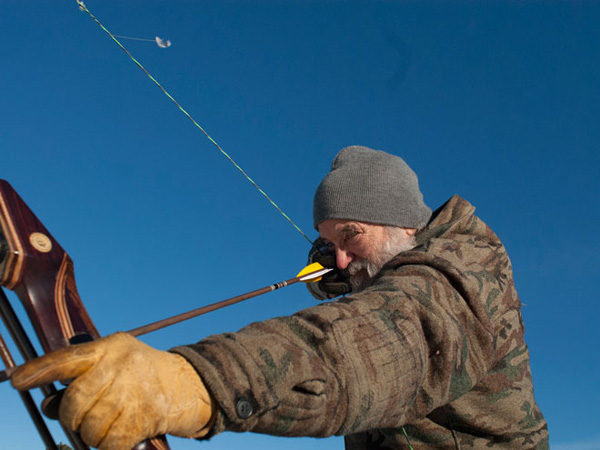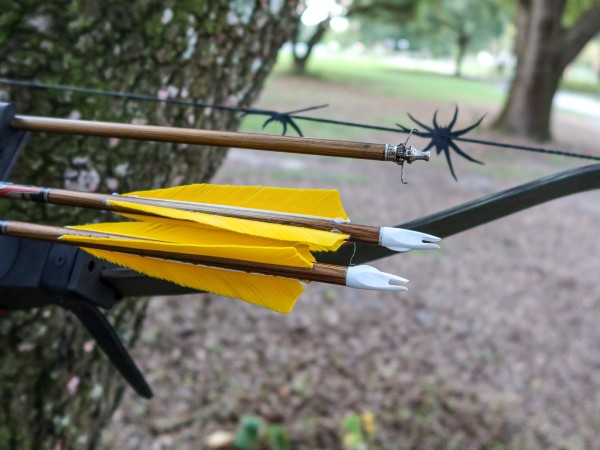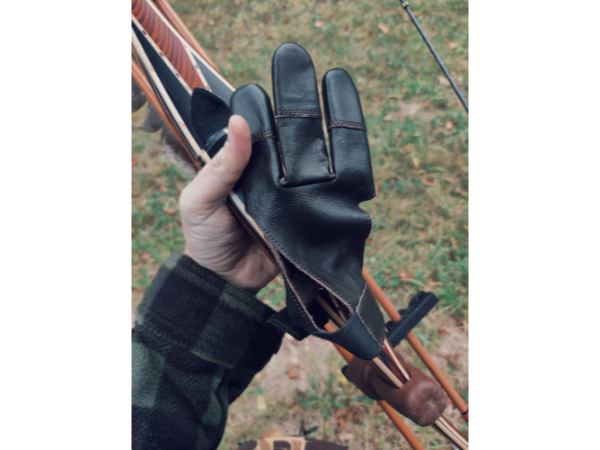Since it’s whitetail season and a lot of us are hunting from trees, do you ever wonder why it’s so easy to shoot too high from a treestand? Sure, bucks do jump the string sometimes, and their first movement is downward, but 3-D targets don’t move and most of us tend to shoot high at them, too.
There’s a simple explanation for this problem. Shooting downward at a steep angle creates a natural tendency to drop the bow arm as you aim. That changes the critical angles in the triangle formed by your bow hand, your drawing hand, and your dominant eye. You shoot high for the same reason you shoot high at a flying bird with a shotgun when you lift your cheek off the stock.
A couple of simple alterations to your shooting form will help. First, make a conscious point to tuck your chin down toward your chest as you come to full draw. That will keep your dominant eye down against your anchor point where it belongs.
Second, concentrate on bending at the waist with your stance otherwise unchanged in order to get your arrow pointed downward at the target. You can practice this from your stand by picking two targets, the first one imaginary and the second one real. Start by picking a spot on a tree 15-20 yards away at eye level and come to full draw on it. Then, while keeping your head and both arms in a stationary relationship with one another, bend at the waist until you’re ready to release at the spot you’ve picked on the ground.
Practice these methods and you’ll be surprised at how many fewer deer wind up jumping the string!







That is a very helpful tip, and one I had to figure out a long time ago when I first began hunting with a traditional bow and shooting instinctively. I believe there is a second reason, however, why we tend to shoot high from tree stands, especially on steep angled shots: Our internal “rangefinders” tend to calculate shot distances on such shots based on the point-to-point distance in feet or yards between the bow and the animal below, when actually the distance for purposes of making the shot is the horizontal distance between the spot on the ground directly beneath the bow and the animal. In other words, when you’re way high up a tree, the distance to the ground makes the animal look farther away than it really is. Or am I all wet?
Ted, you are correct. Here is an excerpt from Shooting Up and Down:
The illustration shows the problem you encounter when shooting uphill and downhill. In this situation, the ram is actually 30 yards in a straight line from the bowhunter, so in his mind he sees the ram at that distance. But the actual lateral distance is only about 21 yards. Gravity pulls on the arrow the same whether going up or down, at least as far as we are concerned in close range bowhunting situations, so the actual shooting distance would be closer to 20 yards, not 30 yards. The result of shooting for 30 yards would be to shoot high, either missing the ram completely or wounding it. Since the vast majority of traditional archers use instinctive shooting, the only way to learn how to shoot uphill and downhill shots is to practice them.
I believe gravity has a greater affect than people realize. Shooting uphill slows the arrow down much more than shooting downhill. If shooting perpendicular to the earths surface… (straight downhill, the arrow will retain speed and angle to the target.) When shooting low…aim low as there is less drop when shooting down. At least that’s how I see it.
Agree with Kevin. Aim for the lower 1/3 of the kill zone and you won’t have to change a thing. Probably, the best thing to do is practice shooting out of a treestand so when the opportunity presents itself there are no surprises.
Article and comments all helpful. Practice like you hunt.
Best advice in the comments—Practice like you hunt.
For the curious, a number of factors come into play. First, let’s look at the forces on the arrow. Upon release, the stored energy in the limbs of the bow is transferred to the arrow as a force propelling the arrow forward. Once the arrow leaves the bowstring, no more force from the bow is imparted to the arrow. In free flight, two additional forces act on the arrow. The instant the arrow begins to move, drag force is imparted to it, caused by the tip of the arrow parting the air, and the surface of the arrow and fletching moving through the air. The drag force is directly opposite to the direction of arrow flight, acting to slow the arrow down as it moves forward. Lastly, at the point where the arrow leaves the bow, gravitational force begins to act on the arrow. Shooting on level ground at a level target, the force of gravity acts directly perpendicular to the path of the arrow. Eventually, gravity pulls the arrow to the ground. If shooting at a level target, gravity forces us to aim higher than the point of intended eventual impact of the arrow on the target. The further away the target, the higher we have to aim in order for the arrow to hit where we want it to. This is because the arrow is in the air longer to reach a farther target, and gravity has more time to act on the arrow’s flight path.
The same basic principles and forces apply to an arrow shot from a tree, however some differences from a level shot will affect where the arrow hits. As already pointed out, point of aim may change due to body geometry changes caused by bending at the waist. Assuming body geometry does not change, gravity acts differently on a downward shot when compared to a level shot. On a downward shot, gravity is now a force that can be broken into two components. One component still acts perpendicular to the arrows flight path, but to a lesser degree than on a level shot. Hence, there is less force pulling perpendicular to the arrow’s flight path. A second component of gravitational force now acts on the arrow, pulling it forward in the direction it is flying, which is towards the ground at some angle. The second component of the gravitational force does not alter the arrows flight path, up or down, because it is pulling the arrow forward in exactly the same direction the arrow is flying. Each component of the gravitational force acting on the arrow is different, based on the angle towards the ground that the arrow is shot at. As someone pointed out, a perfectly straight down shot means there is no gravitational force perpendicular to the arrows flight path. Instead, gravitational force pulls the arrow straight down, and we don’t have to aim high to hit where we want to. Aiming high when shooting straight down means the arrow will hit high. As we shoot out an angle away from straight down, the further out we shoot, the larger the component of the gravitational force acting perpendicular to the arrow. The closer we get to a level shot, even from an elevated position, the higher we must aim to compensate for gravity pulling the arrow down. Shooting at an angle means there is less gravitational force pulling perpendicular on the arrow as it flies, causing it to hit high if we aim the same as if we are shooting on level ground.
Lastly, as also previously pointed out, shooting from an elevated position can be broken down into a right triangle. One leg of the triangle is from the ground to the nock of our arrow on the string. The second leg is the distance from the point on the ground directly below us to our target. The hypotenuse of the triangle is from the arrow nock to our target. The hypotenuse will always be longer than the straight line distance to the target on the ground. If our eye has been trained to aim based on distance from us to target (essentially the hypotenuse), we will overestimate the horizontal distance to the target, aim higher to compensate for what we are seeing, and shoot high in the process. The smaller gravitational force perpendicular to the angled arrow’s path will also cause us to shoot high.
First, practice practice practice, then go hunting. The animals deserve your best.
Next is your safety. His straight top finger on his bow hand should be on the grip. If his broadhead is in front of that finger at full draw, the arrow is to long.
Steve is entirely correct about the physics of trajectory. These factors become practically important when shooting a rifle at 200-300 yards. However, on a typical 15-yard tree stand shot the limited number of gravitational vectors the arrow has to pass through don’t make much practical difference and the difference between the length of the hypotenuse and the base of the triangle also isn’t significant (unless you are taking a 50-yard shot or are shooting from 30 feet up in a tree.) On most tree stand shots, I think form is a far more important factor, and it’s easy to out-think yourself by calculating all the physics. Aim at what you want to hit. Billbow is also correct. I can only say that we were trying to get a photo of the points I was trying to illustrate, and I was getting tired of holding at full draw. Don
One Saturday, in my early bowhunting days, I shot over the backs of three different deer.
My dad, who didn’t bowhunt himself at the time, in one of his many grand shows of support, built a 4’x8′ platform 14′ in the air for me and my friends to practice from.
It helped immensely!
I still hunt almost exclusively from treestands. Now, wrong or not, “bend at the waist” is part of my shot sequence, even when I’m on flat ground in the back yard.
If I’m on the same level with my target, I simply don’t bend, but I still “say it”. This has really helped me when I finally get to “tree up” again every fall.
This advice has served me well, over the years.
My trick to avoid any problem from a tree stand position is:
– always bend first your bow horizontally at full draw; then, move your body downward inbound the target with a minimum deflection of angle depending on the distance you’ll intend to shoot at. We missed in the past bears at short range cause of that.
Thnx Don & TB folks:
This is helpful as for the fist time I plan to “take to the trees” on our acreage via a ladder stand.. Every late October whitetail bucks cruise thru our yard so this year I hope to intercept one!
All the best,
David
I’m no expert but, I have been bow hunting from an elevated tree stand for 40 years or more so. There is a lot of math that comes in to play with angles and distance, but not that complicated to figure out. In today’s advanced world we have tools to figure it out for you if you.Or go with the old rule of thumb that us old guys trialed and set true, which was to just practice at your hunting height with different targets set at different distances and you will dial it in instinctively quickly. Remember safety first and consistency.